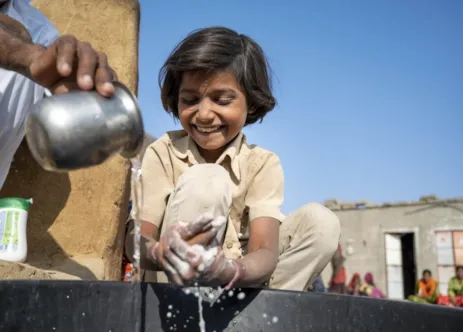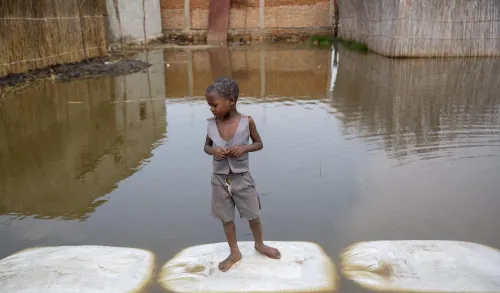CLIMATE CHANGE AND CHILDREN’S RIGHTS
WHAT IS CLIMATE CHANGE?
There is overwhelming scientific evidence on the dangers and causes of climate change. Climate change science indicates that because of past and ongoing greenhouse gas emissions, the world’s climate is already changing. Climate change will contribute to rising temperatures, changing rainfall patterns, and will increase the frequency of droughts, floods and severe weather events.
THE IMPACTS OF CLIMATE CHANGE ON CHILDREN
Climate change is a direct threat to a child’s ability to survive, grow and thrive.
As extreme weather events such as cyclones and heatwaves increase in frequency and ferocity, they threaten children’s lives and destroy infrastructure critical to their well-being. Floods compromise water and sanitation facilities, leading to diseases such as cholera, to which children are particularly vulnerable.
Read more about the devastating impacts of floods on children in Maldives »
Children are the least responsible for climate change, yet they will be the most affected by its impacts.
Droughts and changing global rainfall patterns are leading to crop failures and rising food prices, which result in food insecurity and nutritional deprivations that can have lifelong impacts. These also have the potential to destroy livelihoods, drive migration and conflict, and cripple opportunities for children and young people.
Children are the most vulnerable to diseases that will become more widespread as a result of climate change, such as malaria and dengue fever. Close to 90 per cent of the burden of disease attributable to climate change is borne by children under the age of five.
Approximately two billion children live in areas where air pollution levels exceed standards set by the World Health Organization ─ causing them to breathe toxic air and putting their health and brain development at risk. Every year, over half a million children under the age of five die from air-pollution-related causes. Even more will suffer lasting damage to their developing brains and lungs.
This is the first time a global generation of children will grow up in a world made far more dangerous and uncertain as a result of a changing climate and degraded environment.
Families with a low household income have a harder time coping with shocks. The most vulnerable are already losing their homes, health and education. And as climate change makes crises more common, it becomes harder to recover from them.
Already today, some 785 million people lack access to basic water services. And by 2040, almost 600 million children are projected to live in areas where the demand for water will exceed the amount available.
Without action now, climate change will exacerbate the inequalities that children already face, and future generations will suffer.
According to the latest research from the Intergovernmental Panel on Climate Change, we have less than 11 years to make the transformation necessary to avoid the worst impacts of climate change. The level of carbon dioxide in the atmosphere would have to be cut by 45 per cent by 2030 to prevent global warming above 1.5oC — in other words, the threshold at which the worst impacts of climate change could be averted.
CLIMATE CHANGE SOLUTIONS
The most urgent task ahead is for action to halt the advance of climate change and limit global temperature increases, by curbing greenhouse gas emissions and prioritizing investment in clean, sustainable energy sources. We must act now to help children and communities in vulnerable countries adapt to current and future climate shocks and to ensure resilience to future challenges.
WHAT UNICEF IS DOING TO HELP CHILDREN AFFECTED BY CLIMATE CHANGE
UNICEF works with partners to ensure that children can live in a safe and clean environment. Our actions are structured around four approaches:
Making children the centre of climate change strategies and response plans
UNICEF works with governments and partners globally to ensure children are an essential part of climate change strategies and disaster response plans.
Find out more about how UNICEF does policy advocacy for children »
Recognizing children as agents of change
UNICEF works with young people to elevate their voices on climate change through creative platforms, advocacy and participation at major United Nations summits. Children and young people can also play a key role in addressing climate-related risks by promoting environmentally sustainable lifestyles and setting an example for their communities.
Find out more about how UNICEF is working with youth to address the climate crisis »
Protecting children from the impacts of climate change and environmental degradation
UNICEF supports initiatives to make schools, health centres, water and sanitation facilities – and other services critical to children’s well-being – resistant to climate and environmental shocks. This not only improves children’s resilience to future shocks, but also makes it less likely that today’s inequities will be exacerbated by climate change. Specifically, we aim to support governments in the following areas:
- Climate-smart water, sanitation and hygiene services
- Sustainable energy and disaster risk response in schools
- Sustainable energy and disaster risk response in health centres
Reducing emissions and pollution
UNICEF works to improve air pollution monitoring and advocacy, especially in countries and regions where these systems are sparse or non-existent. A big part of our work is also to support governments to respond to the increased incidence of pneumonia and other respiratory diseases that arise as a consequence of air pollution.
UNICEF is also dedicated to environmental sustainability in its own operations. We are working to transform how and where we work to reduce greenhouse gas emissions and environmental impact, and we have established a dedicated internal fund to support this process. This also includes reducing water and energy consumption, paper use, and waste.



